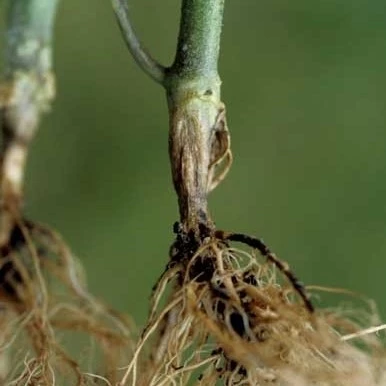Rhizoctonia solani
What is Rhizoctonia solani?
The fungus Rhizoctonia solani is a soilborne pathogen that spreads in wet and warm conditions. It infects many economically vital plants—including greenhouse vegetables, ornamentals, and field crops [1, 2]. Crops affected by this pathogen include peppers, lettuce, potatoes, tomatoes, rice, soybeans, wheat, lilies and turf grass. In fact, it infects more than 200 different plants and does not discriminate (see Tables 1 and 2) [3, 4]. It can be found in hydroponic, greenhouse, or traditional soil farms. One reason it is ubiquitous is that Rhizoctonia solani is a complicated group consisting of 14 different subgroups called anastomosis groups (AGs). Typically, each AG infects a plant group. For example, AG-2-2IIIB, AG-4 and AG-5 are all related to soybean seedling infections, but exceptions like AG-3 have many plant targets [1].
Anastomosis groups (AGs) – different “types” of Rhizoctonia solani are divided into 14 groups called AGs, each with other plant hosts and areas of infection.
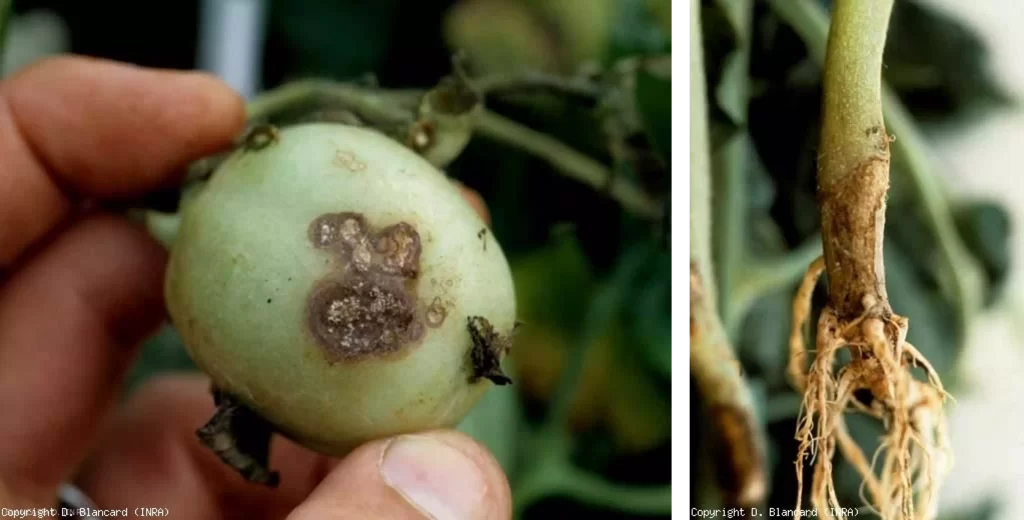
Table 1. A list of Rhizoctonia solani host examples.*
|
Plant Family |
Crop Name |
|
Poaceae (Grasses) |
maize, rice, wheat, barley, oat |
|
Fabaceae (Legumes) |
soybean, peanut, dry bean, alfalfa, chickpea, lentil, field pea |
|
Solanaceae |
tomato, pepper, tobacco, potato, eggplant |
|
Asteraceae |
Lettuce, yarrow |
|
Amaranthaceae |
sugar beet |
|
Brassicaceae |
cabbage, broccoli, cauliflower, Brussels’ sprouts, kohlrabi, kale, rutabaga, turnip, horseradish, canola |
|
Rubiaceae |
coffee |
|
Malvaceae |
cotton |
|
Araceae |
pothos |
|
Moraceae |
figs |
|
Linaceae |
flax |
*Information summarized from [1, 4, 6, 7]
Table 2. A list of ornamentals* most susceptible to Rhizoctonia solani and the disease it causes.
|
Disease |
Most Susceptible Ornamental Plants |
|
Stem rot |
Aster, dianthus, impatiens, poinsettia and pothos. |
|
Root rot |
Aglaonema, azalea, begonia, campanula, ferns, holly, impatiens, juniper, philodendron, poinsettia and spathiphyllum. |
|
Aerial blight |
Azalea, holly, juniper and pittosporum. |
|
Cutting Rot |
Azalea, hydrangea, osteospermum, pittosporum, poinsettia, rosemary, Vinca minor |
|
Damping-off |
Celosia, gomphrena, vinca, impatiens, stock, snapdragon |
|
Bulb rot |
Calla lily, iris, gladiolus |
*Information summarized from [3]
The fungus is mainly known for causing soil-level diseases like stem cankers and lesions but it also infects the roots and leaves. Fruit rots (i.e. tomatoes and strawberries) and belly rots (cucumbers) are also reported [8]–[10]. The infections cause damping off, wilting, stunting and plant death [11, 12]. Globally, Rhizoctonia solani infections are costly; reports range from 52% yield loss in soybean to 56% in tomatoes . Most information and academic articles state significant yield loss regardless of crop type [1, 3, 4, 7, 8, 13]. Rhizoctonia solani favours warm and moist soil conditions, making it a ubiquitous greenhouse and hydroponic pathogen. However, for growers from Ontario, Canada, a strain of Rhizoctonia infects crucifers grown in cool and wet soil [6].
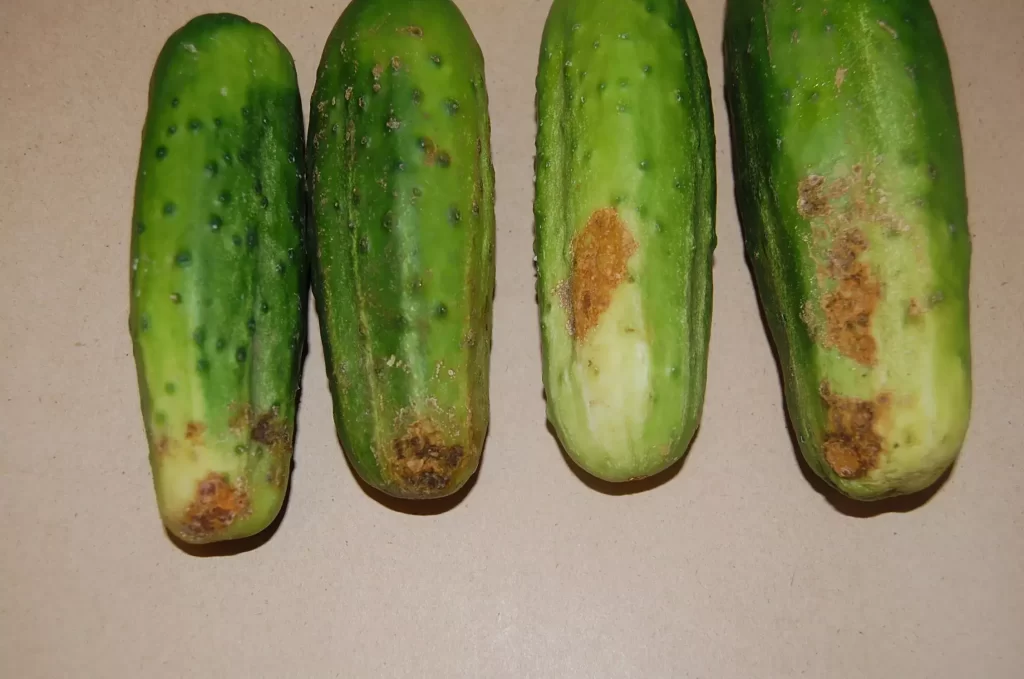
We provide great overviews of many agricultural microorganisms. Subscribe to stay updated!
Symptoms:
Characteristic symptoms of Rhizoctonia solani are damping off, stem lesions, stem cankers, root rot, crown rot, and aerial web blighting [11]. However, it also causes seed rot, hypocotyl rot, limb rot, pod rot, black scurf, seedling blight, and pre-and post-emergence damping off [1]. On fruits, it can cause fruit rots and belly rots on tomatoes, cucumbers, and strawberries [8]–[10]. Aerial blights can infect entire flats of plants in a couple of days [3].
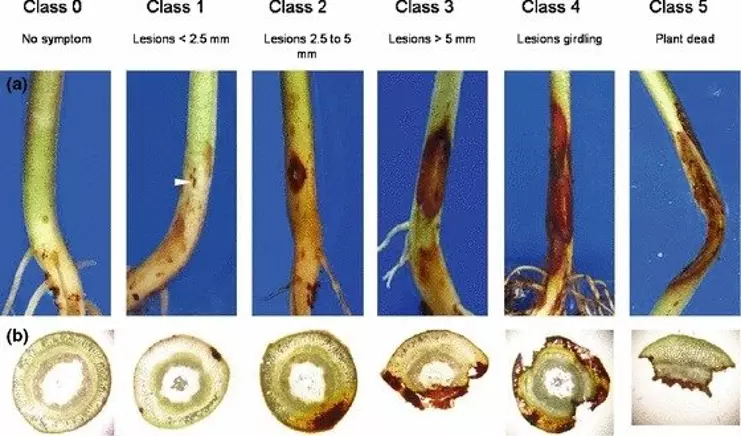
Life Cycle and Infection Stages:
An infection starts when a hyphae (runner hyphae) or a spore settles on a plant. The hyphae divides and grows to what looks like a cushion of hairy mycelia, also known as an infection cushion [16]. As a necrotrophic pathogen, Rhizoctonia solani uses this infection cushion to kill plant cells by releasing enzymes before penetrating the tissue and colonizing the area. Furthermore, fhe fungus also uses the infection cushion to absorb the nutrients from an infected area. Specific AGs use the runner hyphae to branch towards openings like stomata and open wounds [17, 18]. The fungus will continue to invade the plant, spreading out the mycelium mass. When it breaches the xylem, the host plant begins to die [19]. As the host dies, the fungus reproduces both asexually and sexually [1]. In preparation for the death of the host, it builds sclerotia. As saprophytes, they can survive without a host by feeding on organic matter in the soil or growing medium [17].
Hyphae –a long, filament form of a fungal cell
Runner Hyphae – simply put, a long, filament form of a fungal cell that is specialized in starting new colonies
Mycelia – simply put, a group of hyphae
Necrotrophic – when an organism kills living cells to feed off dead organic matter
Sclerotia – a compact mycelium structure with food reserves and typically serves as a survival structure
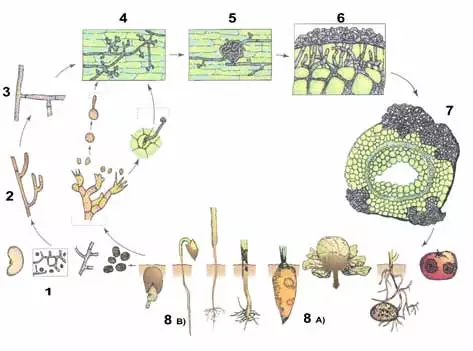
Growth conditions:
Rhizoctonia solani lives in many different environments but favours high temperatures and moisture. It can live in the soil, dead plant material, and host plants as a mass of mycelia and sclerotia. Furthermore, its hyphae and spores are easily dispersed via growing media, water, contaminated plant materials, and working materials [20, 21]. The pathogen prefers warm soil, from 12°C to 32°C (70°F to 90° F). In addition, it also favours moderate soil moisture (65% soil saturation), but it prefers to infect injured plants at higher soil moisture [11, 22]. It is a common greenhouse problem in the US during the summer due to higher heat and humidity [3].
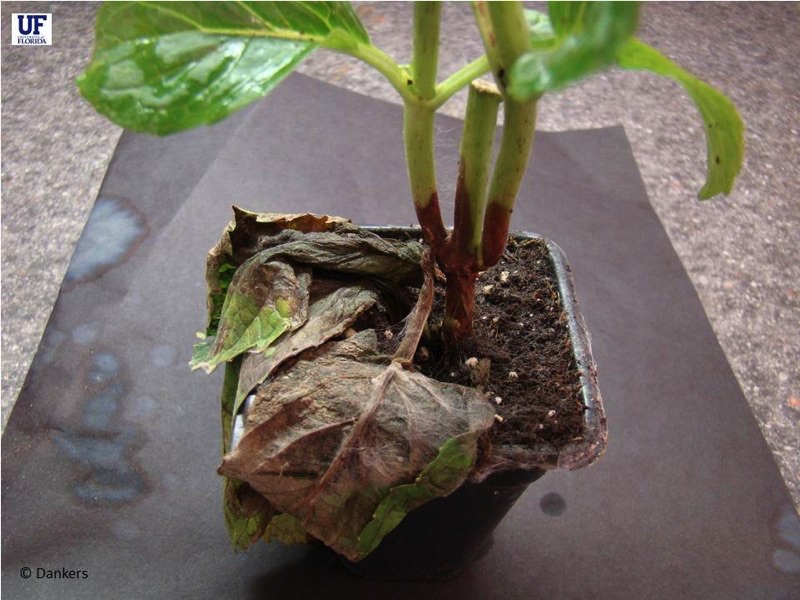
Methods of Prevention and Control
Best Practices
Rhizoctonia solani can spread through water, contaminated surfaces, and any growing medium. The fungus will take advantage of any wet surface; therefore, prevention is the best way to control the fungus. Here are a couple of ways that growers can consider to decrease the risk of infection [3, 6, 11, 23, 24]:
- Use new containers or properly sanitize previously used containers
- Avoid contact with outside soil
- Avoid hose ends and other equipment from touching the ground or soil
- Avoid using contaminated equipment with cuttings
- Water your crops in the morning so they can dry during warmer times of the day
- Increase the airflow between plant leaves
- Increase water drainage
- Be diligent about IPM management, as pests can also be a source of contamination
- Be vigilant and diagnose quickly to allow time to apply control strategies
Treatments
A preventative method that growers should consider are biocontrols that actively work against pathogens. The organism needs to settle in the plant to protect it. Commercially available solutions include Bacillus bacteria and Trichoderma fungi [3, 25, 26]. Traditional chemical treatments are available for treating infections. Please always read the labels and note that different treatments exist for plant types and geographical regions. Here are some example chemical treatments [3, 23, 24, 26]:
- azoxystrobin
- chlorothalonil
- fludioxonil
- picoxystrobin
- prothioconazole
- triticonazole
Here is a link to Health Canada’s list of registered pesticides after typing “rhizoctonia” in the search bar: https://pr-rp.hc-sc.gc.ca/ls-re/result-eng.php?p_search_label=Rhizoctonia&searchfield1=NONE&operator1=CONTAIN&criteria1=&logicfield1=AND&searchfield2=NONE&operator2=CONTAIN&criteria2=&logicfield2=AND&searchfield3=NONE&operator3=CONTAIN&criteria3=&logicfield3=AND&searchfield4=NONE&operator4=CONTAIN&criteria4=&logicfield4=AND&p_operatordate=%3D&p_criteriadate=&p_status_reg=REGISTERED&p_searchexpdate=EXP
Here is a link to United States Environmental Protection Agency’s list of registered pesticides after typing “rhizoctonia” in the search bar: https://search.epa.gov/epasearch/?querytext=rhizoctonia&typeofsearch=area&areaname=Pesticide+Labels&inmeta=WebArea%3DPesticide+Labels#/
Conclusion
Overall, Rhizoctonia solani is an opportunistic pathogen and can catch even a diligent grower off guard, but preventative practices are effective most of the time. In addition, treatments are successful, especially when the disease diagnosis is early. Feel free to send us an email to learn more at [email protected]. Your growing systems will thank you!
Disclaimer:
The information we present in Pathogen Profile is based on collating published peer-reviewed scientific literature and sources we think are reliable. This is by no means an exhaustive review of pathogens. Pathogen Profile gives a small glimpse of what is known about pathogens. We encourage growers to do more research on the pathogens concerning their crops and hydroponic systems. We are not plant pathologists; thus, the information presented in the Pathogen Profile should not be used as professional advice to treat pathogens or operate your hydroponic system.
References
- Ajayi-Oyetunde, O. O., & Bradley, C. A. (2018a). Rhizoctonia solani: taxonomy, population biology and management of rhizoctonia seedling disease of soybean. Plant Pathology, 67(1), 3–17. https://doi.org/https://doi.org/10.1111/ppa.12733
- Chang, K. F., Hwang, S. F., Ahmed, H. U., Strelkov, S. E., Harding, M. W., Conner, R. L., McLaren, D. L., Gossen, B. D., & Turnbull, G. D. (2017b). Disease reaction to Rhizoctonia solani and yield losses in soybean. Canadian Journal of Plant Science, 98(1), 115–124. https://doi.org/10.1139/cjps-2017-0053
- Chase, A. (2011c). Rhizoctonia Diseases in Summer. Greenhouse Management. https://www.greenhousemag.com/article/greenhouse-0611-rhizoctonia-diseases-summer-plant-health/
- Downer, A. J., Harivandi, M. A., Grebus, M. E., Hartin, J., & Wong, F. (2016d). Rhizoctonia Blight (Brown Patch, Large Patch, Yellow Patch). Agriculture: Turfgrass Pest Management Guidelines. https://www2.ipm.ucanr.edu/agriculture/turfgrass/Rhizoctonia-blight-Brown-patch-Large-patch-Yellow-patch/#:~:text=Reduce shading and improve soil,by poling or light irrigation.
- Ephytia. (2021e). Thanatephorus cucumeris (Rhizoctonia solani, rhizoctone brun). Ephytia. https://ephytia.inra.fr/en/C/5309/Tomato-Main-symptoms
- Garibaldi, A., Tabone, G., Bertetti, D., & Gullino, M. L. (2021f). First report of Rhizoctonia solani AG-1 IB causing crown rot on Achillea millefolium in Italy. Journal of Plant Pathology, 103(2), 723. https://doi.org/10.1007/s42161-021-00799-0
- Gondal, A. S., Rauf, A., & Naz, F. (2019g). Anastomosis Groups of Rhizoctonia solani associated with tomato foot rot in Pothohar Region of Pakistan. Scientific Reports, 9(1), 3910. https://doi.org/10.1038/s41598-019-40043-5
- GONZALEZ, M., PUJOL, M., METRAUX, J.-P., GONZALEZ-GARCIA, V., BOLTON, M. D., & BORRÁS-HIDALGO, O. (2011h). Tobacco leaf spot and root rot caused by Rhizoctonia solani Kühn. Molecular Plant Pathology, 12(3), 209–216. https://doi.org/https://doi.org/10.1111/j.1364-3703.2010.00664.x
- Goodwill, T., & Hanson, L. (2011i). Rhizoctonia belly rot in cucumber fruit using Rhizoctoniasolani isolated from sugar beet. https://doi.org/10.5274/ASSBT.2011.105
- Hartley, D. E. (1992j). 12 – Poinsettias (R. A. B. T.-I. to F. (Second E. Larson (ed.); pp. 305–331). Academic Press. https://doi.org/https://doi.org/10.1016/B978-0-12-437651-9.50017-8
- Health Canada. (2022k). Consumer Product Safety. Pesticides & Pest Management. https://pr-rp.hc-sc.gc.ca/ls-re/result-eng.php?p_search_label=Rhizoctonia&searchfield1=NONE&operator1=CONTAIN&criteria1=&logicfield1=AND&searchfield2=NONE&operator2=CONTAIN&criteria2=&logicfield2=AND&searchfield3=NONE&operator3=CONTAIN&criteria3=&logicfie
- Lawson, L. (n.d.-l). Rhizoctonia Root Rot: Symptoms And How To Control. PROMIX. https://www.pthorticulture.com/en/training-center/rhizoctonia-root-rot-symptoms-and-how-to-control/
- Ludovic, F., Nassr, N., Lebeau, T., & Walter, B. (2008m). Effects of the Plant Defence Inducer, Acibenzolar‐S‐Methyl, on Hypocotyl Rot of Soybean Caused by Rhizoctonia solani AG‐4. Journal of Phytopathology, 156, 236–242. https://doi.org/10.1111/j.1439-0434.2007.01367.x
- Michigan State University. (n.d.-n). Pathogen: Rhizoctonia solani. Michigan State University: Plant and Pest Diagnostics. https://www.canr.msu.edu/resources/rhizoctonia-solani
- Moorman, G. W. (2014o). Rhizoctonia. PennState Extension. https://extension.psu.edu/rhizoctonia
- OMAFRA. (2009p). RHIZOCTONIA. Ontario Crop IPM. http://www.omafra.gov.on.ca/IPM/english/brassicas/diseases-and-disorders/rhizoctonia.html#advanced
- Ortega-Acosta, S. Á., Palemón-Alberto, F., Terrones-Salgado, J., Molina-Gayosso, E., Romero-Ramírez, Y., Toribio-Jiménez, J., Villar-Luna, E., Bárcenas-Santana, D., Juárez-López, P., Cruz-Lagunas, B., & Reyes-García, G. (2021q). First Report of Rhizoctonia solani AG-4 HG-I Causing Fruit Rot on Tomato in Mexico. Plant Disease, 106(5), 1531. https://doi.org/10.1094/PDIS-09-21-2005-PDN
- P, A., & Vijayaraghavan, R. (2019r). Characterization of Rhizoctonia solani causing Fruit rot of Strawberry (Fragaria x ananassa Duch.) in Wayanad and in vitro Evaluation of Fungicides, Organic preparations and Bioagents for its Management (F. A. O. of the UN (ed.); Vol. 14, Issue 2, pp. 155–160). https://jhs.iihr.res.in/index.php/jhs/article/view/800
- RODDY, E. (2014s). Research Update – Rhizoctonia Belly Rot of Cucumbers. ONvegetables. https://onvegetables.com/2014/07/07/research-update-rhizoctonia-belly-rot-of-cucumbers/
- Tredway, L. P., & Burpee., L. L. (2001t). Rhizoctonia diseases of turfgrass. The Plant Health Instructor. https://www.apsnet.org/edcenter/disandpath/fungalbasidio/pdlessons/Pages/Rhizoctonia.aspx
- University of Massachusetts Amherst. (2022u). Gerbera – Web blight (Rhizoctonia). UMass Extension Greenhouse Crops and Floriculture Program Back to Top. https://ag.umass.edu/greenhouse-floriculture/photos/gerbera-web-blight-rhizoctonia#:~:text=Fungicides for the control of,Medallion%2C Terraclor%2C and Terraguard.
- Weinhold, A. R., & Sinclair, J. B. (1996v). Rhizoctonia Solani: Penetration, Colonization, and Host Response BT – Rhizoctonia Species: Taxonomy, Molecular Biology, Ecology, Pathology and Disease Control (B. Sneh, S. Jabaji-Hare, S. Neate, & G. Dijst (eds.); pp. 163–174). Springer Netherlands. https://doi.org/10.1007/978-94-017-2901-7_14
- Wick, R. L., & Madeiras, A. (2019w). Root Diseases of Greenhouse Crops. UMass Extension Greenhouse Crops and Floriculture Program. https://ag.umass.edu/greenhouse-floriculture/fact-sheets/root-diseases-of-greenhouse-crops#:~:text=Rhizoctonia solani causes damping-off,upper portion of the soil.
- Woude, K. Van der. (2013x). Technical Leaflet on Rhizoctonia. https://www.florimond-desprez.com/es/wp-content/uploads/sites/6/2015/11/rhizoctonia_eng.pdf
- Wright, J. (2013y). Greenhouse Diseases 101: Rhizoctonia. Greenhouse Grower. https://www.greenhousegrower.com/production/crop-inputs/greenhouse-diseases-101-rhizoctonia/#:~:text=Rhizoctonia does not produce spores,thrives in normal greenhouse conditions.
- Zrenner, R., Genzel, F., Verwaaijen, B., Wibberg, D., & Grosch, R. (2020z). Necrotrophic lifestyle of Rhizoctonia solani AG3-PT during interaction with its host plant potato as revealed by transcriptome analysis. Scientific Reports, 10(1), 12574. https://doi.org/10.1038/s41598-020-68728-2
![]()
David Santos is a Biotech and Agriscience Advisor at Healthy Hydroponics


